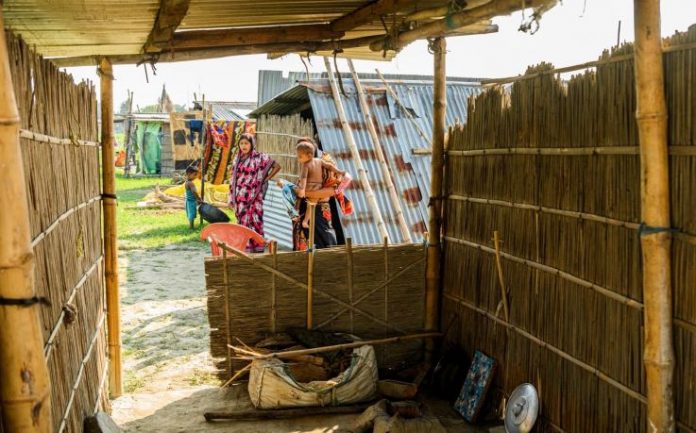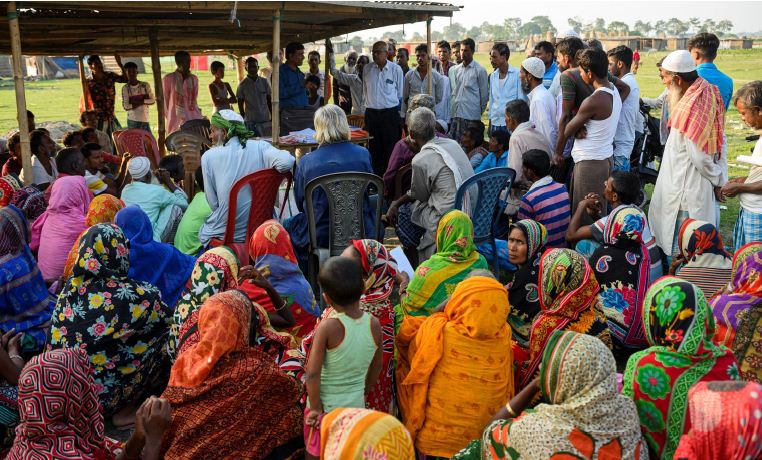
Since the Bharatiya Janata Party (BJP) formed the government in Assam in 2016, the state has witnessed a spree of evictions uprooting thousands of people. The forced eviction drive became rampant after Himanta Biswa Sarma took charge as chief minister in 2021.
Mahibul Hoque | TwoCircles.net
GUWAHATI – The forced eviction drive of Bengali speaking Muslims in Assam by the state government was aimed at serving “vested interest with ulterior motives” against the people who were victims of climate-induced displacement and who were already cultivating the land, said an enquiry report conducted by India’s academicians and anti-displacement activists.
Moinul Hoque and a minor Sheik Farid were gunned down by the state police during the eviction drive on September 23. The most brutalizing aspect of the forced eviction was “sheer contempt on part of the government for the safety of the lives and livelihoods of thousands of people,” said the report while referring to the uprooting of over a thousand families who were displaced from their homes.
Since the Bharatiya Janata Party (BJP) formed the government in Assam in 2016, the state has witnessed a spree of evictions uprooting thousands of people. The forced eviction drive became rampant after Himanta Biswa Sarma took charge as chief minister in 2021.
The inquiry team, an initiative of Delhi-based Janhastakshep included Professor Vikas Bajpai of Jawaharlal Nehru University, Professor Biswajeet Mahonty from Delhi University and Bhubaneshwar based journalist and anti-displacement activist Sudhir Pattnaik. They visited the area where Moinul Hoque and 12-year-old Sheik Farid were gunned down by state police during the eviction drive on September 23.
Professor Bajpai, the author of the enquiry report highlighted the design of the BJP government to target the poor Bengali Muslims by projecting them as “encroachers” and invoking Assamese nationalism.
“Exercised Deception”
The district police administration “deliberately exercised deception” to catch the people unawares. Citing the eviction notice served to one villager, the enquiry team in its report said that the notice was served upon him (Zaheerul Islam) at 12 am on the night of 19 September, and the next morning the police and administration descended upon his house to demolish it.
“The words stating that he needed to be evicted from his place within three months of receiving the notice had been erased with white ink. This clearly illustrates the intent of the administration.”

Victims denied compensation
The team said that there was little intent of the state government to provide appropriate compensation or rehabilitation of the evicted people.
“The government is post-facto imposing conditions for giving compensation to the affected people such as those whose names appear in the NRC, or incumbent upon people being able to prove that they were not illegally occupying any land,” read the enquiry report.
The enquiry team called out Assam Chief Minister Sarma’s comment that only 60 families lived in the villages affected by the forced eviction drive. “We found that a total of 966 families amounting to about seven thousand people have been evicted. Also, the evicted people pointed out that more than half of the allegedly encroached 77,000 bighas had already been eroded by the Brahmaputra River.”
Temple in the background
The report underlined that the contentions at the villages began with the demand for “freeing encroachment of temple land” by a certain section of Hindus living at a distance where they demanded that 180 bigha land of an ancient temple was encroached upon by the Muslim dwellers.
The supposedly ancient temple — a Shiva Temple situated atop the hillock at Dholpur No 2 village— was set up by the husband of Parvati Das during 1983-84.
The enquiry team alleged that “there is an ulterior motive behind Assam government’s move of forced evictions,” and said that Parvati’s testimony substantiated their allegations.
Muslims contributed to building temple
According to the report, Parvati Das said that the Sattra (temples of the Vaishnavite cult in Assam) in Dhalpur village had been set up by her husband. Even though there were no Hindu families in the neighbourhood, the Muslim households in the village had contributed to the building of the temple.
After the temple was built, some Hindus belonging to the villages across the Brahmaputra started performing puja in the temple and formed a committee to manage its affairs. On the temple committee’s demand, the temple was allocated 120 bighas of land to generate revenue for its upkeep. However, this land got eroded by the river over the years, and now a fresh demand has been raised by the committee for 175 bighas of land to be allotted.”
Temple founder’s house destroyed in eviction drive
Though Parvati’s husband had set up the temple, she had little say in the matters of the temple after her husband passed away. Her house was also destroyed during the June round of evictions at Dholpur Two village.
The Assam government planned to convert supposedly 77,000 bigha land in the riverine sandbank to an agricultural farm for employment generation for ‘indigenous people’. However, evidently, the land was utilized by the villagers who are mostly victims of climate-induced displacement using their traditional farming knowledge.
Mahibul Hoque is a SEED Fellow with TwoCircles.net. He tweets at @H_Mahibul.

